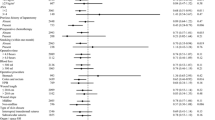Abstract
Background: Wound protectors are plastic sheaths that can be used to line a wound during surgery. Wound protectors can facilitate retraction of an incision without the need for other mechanical retractors and have been proposed as deterrents to wound infection. The purpose of this study was to define the ability of wound protectors to reduce the rate of infection when used in laparoscopic-assisted colectomy. Methods: We completed a retrospective review of the medical records of patients undergoing nonemergent laparoscopic-assisted colectomy between February 1999 and November 2002. All completely laparoscopic cases were excluded. The wound protector, when used, was applied to the extraction incision during the externalized portion of the procedure (colon and mesentery transection, anastomosis). Outcomes for patients with and without the use of a wound protector were compared. Results: A total of 141 patients underwent laparoscopic-assisted colectomy (98 for benign/malignant tumors, 35 for diverticular disease, and eight for Crohn’s disease). There were no differences between the wound protector group (n = 84) and the no wound protector group (n = 57) with respect to mean age (55 vs 58 years), average body mass index (27 vs 29 kg/m2), gender, indication for surgery, comorbidities, antibiotics used, or mean operative time (185 vs 173 min). Nine patients in the wound protector group and eight in the no wound protector group developed a wound infection at the colon extraction site (p = 0.42). Patients undergoing resection for Crohn’s disease or diverticulitis had a higher infection rate (18.6%) than patients undergoing resection for polyps or cancer (9.2%; p < 0.05). No wound recurrence of cancer was observed in either group at a mean follow-up of 23 months (range, 3–48). Conclusions: The wound protector, although useful for mechanical retraction of small wounds, does not significantly diminish the rate of wound infection at the bowel resection/anastomotic site. Patients undergoing elective resection for inflammatory processes have higher infection rates than patients undergoing laparoscopic-assisted colectomy for polyps or cancer.


Similar content being viewed by others
References
ML French HE Eitzen MA Ritter (1976) ArticleTitleThe plastic surgical adhesive drape: an evaluation of its efficacy as a microbial barrier. Ann Surg 184 46–50 Occurrence Handle1:STN:280:CSmB3s%2Fls1c%3D Occurrence Handle938118
InstitutionalAuthorNameHALS Study Group (2000) ArticleTitleHand-assisted laparoscopic surgery vs standard laparoscopy for colorectal disease. Surg Endosc 14 896–901
HW Harrower (1968) ArticleTitleIsolation of incisions into body cavities. Am J Surg 116 824–826 Occurrence Handle1:STN:280:CCaD2Mrot1Y%3D Occurrence Handle5723859
DW Jackson AV Pollock DS Tindal (1971) ArticleTitleThe value of a plastic adhesive drape in the prevention of wound infection. A controlled trial. Br J Surg 58 340–342 Occurrence Handle1:STN:280:CS6C1cnmtFI%3D Occurrence Handle4930141
T Nakagoe T Sawai T Tsuji A Nanashima M Jibiki H Yamaguchi T Yasutake H Ayabe K Shimomura (2001) ArticleTitleMinilaparotomy wound edge protector (Lap-Protector): a new device. Surg Today 31 850–852 Occurrence Handle10.1007/s005950170065 Occurrence Handle1:STN:280:DC%2BD3MnhtF2ntg%3D%3D Occurrence Handle11686573
PO Nystrom L Brote (1980) ArticleTitleEffects of a plastic wound drape on contamination with enterobacteria and on infection after appendicectomy. Acta Chir Scand 146 65–70 Occurrence Handle1:STN:280:Bi%2BC1MvislY%3D Occurrence Handle6990669
JL Peacock WT Lawrence EE Peacock (1993) . JP O’Leary (Eds) The physiologic basis of surgery. Williams & Wilkins Baltimore 95–111
JV Psaila MH Wheeler DL Crosby (1977) ArticleTitleThe role of plastic wound drapes in the prevention of wound infection following abdominal surgery. Br J Surg 64 729–732 Occurrence Handle1:STN:280:CSeD2c%2FpvVM%3D Occurrence Handle922295
D Raahave (1976) ArticleTitleEffect of plastic skin and wound drapes on the density of bacteria in operation wounds. BrJ Surg 63 421–426 Occurrence Handle1:STN:280:CSmB3cjis1A%3D
S Sookhai HP Redmond JM Deasy (1999) ArticleTitleImpervious wound-edge protector to reduce postoperative wound infection: a randomised, controlled trial. Lancet 353 1585 Occurrence Handle10.1016/S0140-6736(99)00950-2 Occurrence Handle1:STN:280:DyaK1M3msFChug%3D%3D
L Stocchi H Nelson (2000) ArticleTitleWound recurrences following laparoscopic-assisted colectomy for cancer. Arch Surg 135 948–958 Occurrence Handle10.1001/archsurg.135.8.948 Occurrence Handle1:STN:280:DC%2BD3cvhs12rtw%3D%3D Occurrence Handle10922258
EM Targarona E Gracia J Garriga . Martinez-Bru M Cotes R Boluda L Lerma M Trias (2002) ArticleTitleProspective randomized trial comparing conventional laparoscopic colectomy with hand-assisted laparoscopic colectomy. Surg Endosc 16 234–239 Occurrence Handle10.1007/s00464-001-8168-9 Occurrence Handle1:STN:280:DC%2BD383jtVWrtg%3D%3D Occurrence Handle11967670
JC Weeks H Nelson S Gelber D Sargent G Schroeder (2002) ArticleTitleShort-term quality-of-life outcomes following laparoscopic-assisted colectomy vs open colectomy for colon cancer: a randomized trial. J Am Med Assoc 287 321–329 Occurrence Handle10.1001/jama.287.3.321
JA Williams GD Oates PP Brown DW Burden J McCall AG Hutchison LJ Lees (1972) ArticleTitleAbdominal wound infections and plastic wound guards. Br J Surg 59 142–146 Occurrence Handle1:STN:280:CSqD3cnlvVU%3D Occurrence Handle4212905
D Zoutman S McDonald D Vethanayagan (1998) ArticleTitleTotal and attributable costs of surgical-wound infections at a Canadian tertiary care center. Infect Control Hosp Epidemiol 19 254–259
Author information
Authors and Affiliations
Corresponding author
Rights and permissions
About this article
Cite this article
Kercher, K., Nguyen, T., Harold, K. et al. Plastic wound protectors do not affect wound infection rates following laparoscopic-assisted colectomy . Surg Endosc 18, 148–151 (2004). https://doi.org/10.1007/s00464-003-8137-6
Received:
Accepted:
Published:
Issue Date:
DOI: https://doi.org/10.1007/s00464-003-8137-6




